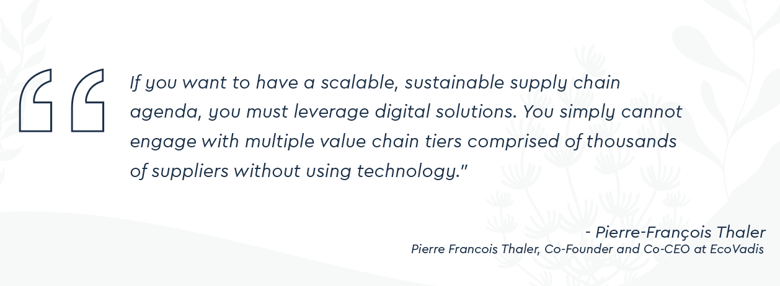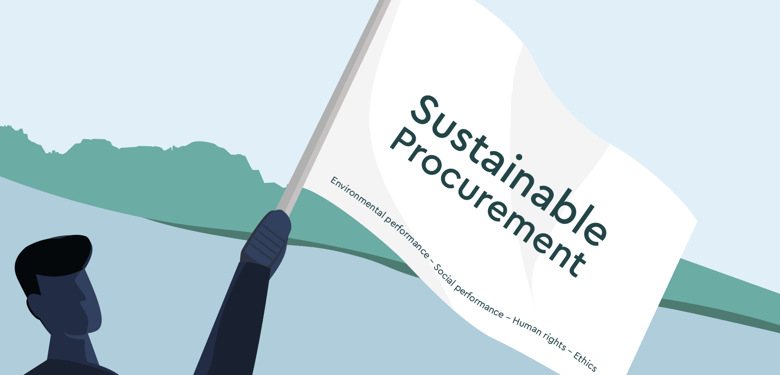
Thought Leadership
Setting the Stage for Sustained Sustainability

Kelly Barner • Feb 25, 2021

Procurement is rapidly evolving into a strategic function entirely powered by data-derived insights. Access to high quality, actionable data determines not only how valuable procurement is to corporate profitability, but also the extent to which they can measurably contribute to increased market share and competitive advantage.
In this article, we focus on data and analytics’ potential contributions to supply chain sustainability based on a conversation with Pierre Francois Thaler, Co-Founder and Co-CEO at EcoVadis. He shared his insight into what is required to drive measurable changes at scale that meet each buy-side company’s needs for verifiable improvements in supply chain sustainability.
Defining Sustainable Procurement
Sustainable procurement expands upon traditional supplier evaluation factors such as product/service cost and quality by emphasizing environmental performance, social performance, human rights, ethics, and more. Suppliers are expected to invest in their own sustainability practices and also to manage the sustainability of their supply chain – including the impacts of the commodities and products they use and produce (known as "product sustainability").

Depending upon where a company is based,sustainability and supplier diversity may be part of the same effort or they may be separate. The United States tends to divide them while Europe usually combines them. Regardless of how they are managed and owned, however, there is a great deal of overlap in the foundational intent and philosophy that give these initiatives life, as well as in the return they offer to the business.
Expanded notions of responsibility are leading all companies to reexamine their supply chains holistically and as separate tiers. As Thaler explained, “We’ve seen an incredible acceleration in the number of regulations related to supply chain sustainability. You are responsible for whatever happens in your supply chain, from human rights to environmental concerns; that concept is becoming the norm.”
In many cases, a company declares the launch of a sustainability initiative to signal their intent to improve the environmental and social impact of their supply chain. Understanding the baseline performance of the existing supply chain is the only place to start such an effort. Companies should not announce forward-looking sustainability initiatives if they haven’t taken care of the basics in their supply chain first. Doing so with the support of a broad executive mandate is key, as is supporting sustainability initiatives from the bottom up.
The sourcing process provides one key opportunity to integrate sustainability criteria, but it is not the only opportunity. Rather than just evaluating individual suppliers participating in RFPs, procurement should assess supply base sustainability broadly, visiting and revisiting sustainability scores during contract negotiation, relationship management, annual or quarterly performance reviews, and when establishing criteria for 'preferred supplier’ programs.
Sustainability is a continuous improvement journey that should expand and evolve as long as the company continues to innovate in partnership with suppliers. The types of ROI are as many and varied as the sources of insight that decision makers are able to access and incorporate with the support of procurement analytics.
Required: Digital Scalability
The challenge of implementing a sustainability program at scale can only be met with digital tools. The value of sustainability ratings data grows as it is integrated with information and technology that is already in use for day-to-day work. This includes spend analysis, supplier information management, opportunity assessment, and performance tracking.
The following graphic displays digital scalability in action. Sievo pulls suppliers’ sustainability assessment data from EcoVadis and automatically matches it with suppliers in the company’s spend analytics system. By placing sustainability ratings alongside more traditional procurement analytics such as spend per supplier, supplier fragmentation by category, and spend per business unit, insight becomes more relevant and actionable. From Sievo, users can click back into EcoVadis’ supplier scorecards to access further details about how they have scored and where they may have room for improvement. This API integration also enables Sievo users to launch new assessment requests for suppliers that aren’t yet in EcoVadis’ database.

By seamlessly integrating insights with processes, and tasks with business objectives, distributed buyers further corporate sustainability by simply going about their work. Information is centrally maintained but made available in a distributed fashion, achieving quality and reliability without sacrificing practicality.
How to Measure and Influence Supplier Sustainability
Sustainability ratings vary by oversight body, country, and spend category. There are multiple frameworks and standards such as the Global Reporting Initiative’s (GRI) sustainability standards, Sustainability Accounting Standards Board (SASB), and ISO 26000 for social responsibility that make it possible to compile sustainability data. Since most large companies use one or more of these frameworks to report their overall sustainability data to investors and stakeholders, it is important that their supply chain assessment program be aligned with those criteria and management system indicators. Even staying on top of these standards is a complex effort, and with additional fragmentation by industry and geography, it can be hard for sustainability directors to stay focused on what they are trying to deliver for the business.
This level of complexity is what led EcoVadis to develop one rating that indicates a supplier’s sustainability performance across 21 different factors. Digital tools have made it possible to address the significant scope of the data and data sources required to create such a score and preserve its reliability over time. Flagging changes in supplier sustainability ratings is just as critical as assessing them in the first place, requiring automated notifications and pre-set tolerance levels.
 EcoVadis supplier scores provide actionable insights in Sievo’s Sustainability Dashboard
EcoVadis supplier scores provide actionable insights in Sievo’s Sustainability Dashboard
Thaler recommends a two-pronged approach to practically incorporating sustainability performance information in an existing supply chain:
Sustainability Among Strategic Partners:
These are the suppliers a company collaborates closely with, and without whom they may lose their competitive advantage. These suppliers should carry high sustainability ratings and be committed to continuous improvement, with the full support of their most important customers.
Poor Sustainability and Tail Spend:
Existing suppliers with low scores - even when they are just present in long tail spend - should be worked out of the supply base and replaced with more sustainable alternatives. Not only does this demonstrate that the company is taking a logically consistent approach to sustainability, it protects them from negative press in the case that even a small supplier is accused of undesirable practices.
Management and measurement are closely linked to clear organizational ownership. Who should own sustainability and where should they report? According to Thaler, “a sustainable supply chain leader should report into the Chief Procurement Officer.” Sustainability has to be backed by a clear executive mandate and a specific process for engaging with tens of thousands of suppliers. In addition, the director of sustainability cannot expect to act in isolation or solely within procurement. They will need to join forces with functions such as supply chain and operations, making sustainability center-led and distributed at the same time.
In conclusion…
In order for sustainability initiatives to flourish, companies need to work defensive and offensive strategies in parallel. This means ensuring that key partners have high, improving sustainability scores and that low scoring suppliers improve significantly or are gradually replaced. And, of course, sustainability initiatives are never complete. They represent an expansive and value-oriented way of working and approaching the market. Just as the market never stops evolving, the potential of sustainability initiatives is never exhausted.
About Deep-dive into Procurement Data Ecosystems with Kelly Barner
This article series was written by Kelly Barner, top procurement influencer and owner of Buyers Meeting Point.
All companies require data in order to function, but in today’s hyper-connected world, large enterprises have specific additional needs around technology-enabled scalability and standardization that smaller organizations may be able to get by without or supplement with manual alternatives. These multi-faceted data challenges exist within and outside of their procurement operations.
In order to explore and articulate the multi-faceted data requirements of large enterprises, we reached out to several leading companies to gain unique insight into the criticality of linking internal data and third-party data via robust procurement analytics capabilities. The result is a thoughtful article series that explores fresh ways procurement leaders can turn data from a challenge to opportunity.
Dive deeper into procurement data in the new ebook featuring Kelly Barner’s interviews with visionary procurement software leaders from Basware, EcoVadis, riskmethods, Supplier.io and Sievo.
Open Positions
Welcome to explore our open job opportunities around the world
- Position
- Location
- Apply Before


